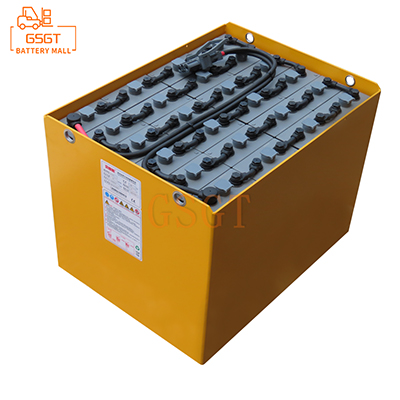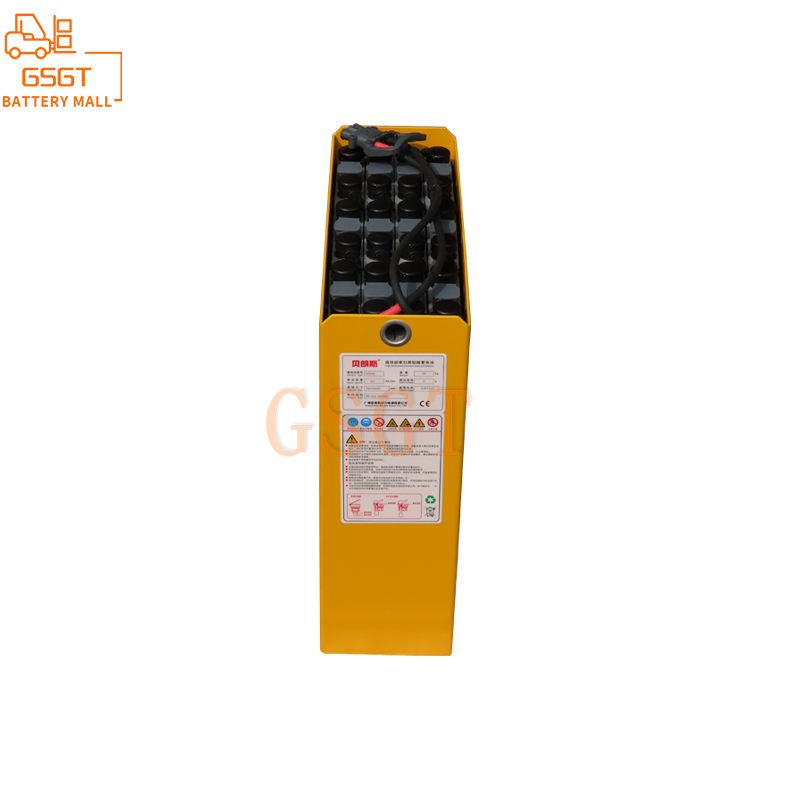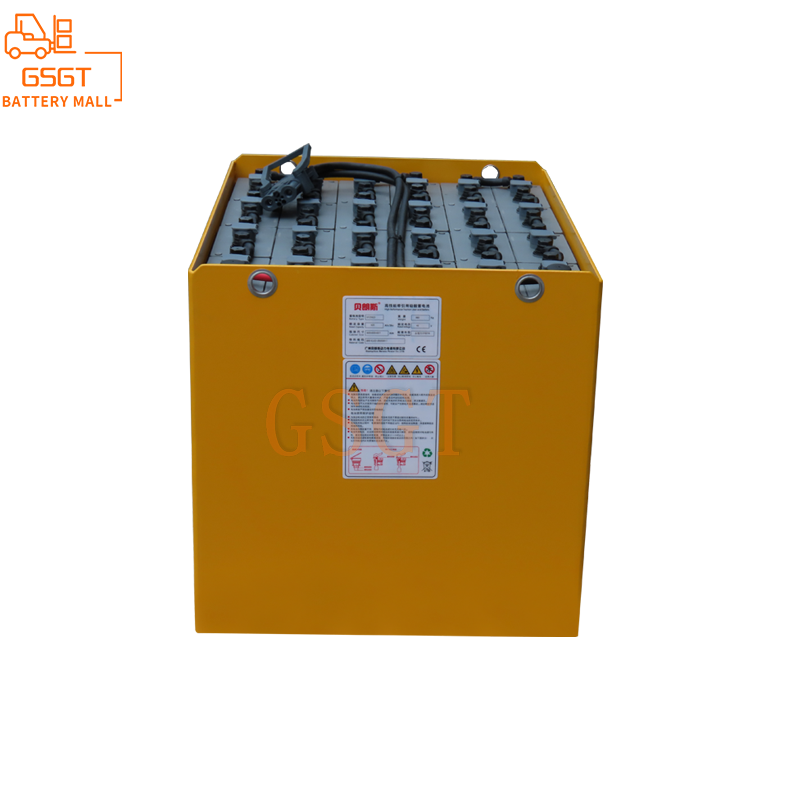Time:2025-04-17 10:52:12
Browse:605
In the field of industrial logistics, forklifts are indispensable handling equipment, and lead-acid batteries as the power source of many forklifts, the stability of their performance is directly related to the efficiency and operating costs of forklifts. A thorough understanding of the common faults of lead-acid batteries and corresponding solutions is essential to ensure the efficient operation of forklifts.
Capacity decline
● Fault performance
When the forklift works, the driving range under the full power state is significantly shortened, and the original can complete multiple shifts, but now it can only support one or two shifts, and the power decay is fast during the operation, and it is difficult to lift heavy objects.
● Reason analysis
1. **Plate vulcanization**: in the state of undercharge for a long time, the lead sulfate inside the battery can not be completely converted into active substances, and gradually form a white and hard lead sulfate crystal on the plate, which hinders the normal electrochemical reaction, reduces the utilization rate of active substances on the plate, resulting in a decrease in capacity. For example, the frequency of use of forklifts is low, each charge time is insufficient, and the battery is idle for a long time in a semi-electric state, which is prone to plate vulcanization.
2. ** Electrolyte drying ** : Due to the gas generated during the charging process to take away water, or the battery shell seal is not strict resulting in electrolyte leakage, so that the electrolyte level is reduced, the plate part is exposed to the liquid surface, and the area involved in the electrochemical reaction is reduced, resulting in a reduction in battery capacity.
3. ** plate aging ** : After a long period of charge and discharge cycle, the active substance on the plate will gradually fall off, resulting in a decrease in the effective reaction area of the plate and a decrease in battery capacity. Under normal circumstances, the number of charge and discharge cycles of lead-acid batteries is about 300-500 times, and after reaching a certain number of times, the aging problem of the plate will be highlighted.
● Solution
1. ** For plate vulcanization ** : The use of de-vulcanization charging method, that is, first with a small current for a long time to charge the battery voltage to about 2.5V, and then discharge, so repeated many times, try to dissolve the lead sulfate crystal on the plate. There are also specialized battery repair devices on the market that can break lead sulfate crystals through pulse repair technology to restore plate activity. In daily use, it is necessary to ensure that the forklift battery is fully charged every time to avoid long-term undercharge, and for idle forklifts, it is also necessary to supplement and charge regularly.
2. ** Should the electrolyte dry ** : Check the battery shell and connection for leakage phenomenon, if so, replace the seal or repair the shell in time. For the electrolyte drying due to the loss of charging water, distilled water or a special lead-acid battery supplement liquid should be added to the appropriate level, and a complete charge and discharge cycle should be carried out after adding, so that the electrolyte is fully mixed and uniform.
3. ** To solve the plate aging problem ** : When the plate aging is serious, the capacity decreases by more than a certain degree (such as less than 60% of the rated capacity), and the repair effect is not good, it is necessary to replace the new battery in time. When choosing a new battery, it is necessary to select products with reliable quality and suitable capacity according to the working intensity and use environment of the forklift.
Charging abnormal
●Fault performance
When charging, the battery heats up seriously, the temperature is too high or even hot; The charging time is too long, far beyond the normal charging time, but the battery is still not full; Or the initial charging voltage rises too fast, and then drops rapidly after reaching the upper limit.
●Reason analysis
1. ** Charging equipment failure ** : The charger output voltage is unstable, too high or too low will affect the normal charging of the battery. For example, the voltage regulator circuit inside the charger is damaged, which may output too high voltage, resulting in overcharging of the battery and serious heating; If the output voltage is too low, the battery cannot be fully charged.
2. ** Battery internal short circuit ** : Short circuit may occur between the plates due to the active material falling off and accumulation, partition damage and other reasons. The resistance at the short circuit is very small, and the current will be concentrated at the short circuit point, generating a lot of heat, causing the battery to heat up, and affecting the charging effect, making the charging voltage abnormal.
3. ** Abnormal charging ambient temperature ** : The best charging temperature of the lead-acid battery is about 25 ° C, when the ambient temperature is too high, the chemical reaction speed inside the battery is accelerated, and the charging acceptance is enhanced, which is easy to lead to overcharging, causing the battery to heat up and the voltage to rise abnormally; When the ambient temperature is too low, the viscosity of the electrolyte increases, the ion diffusion rate slows down, the internal resistance of the battery increases, the charging is difficult, and the charging time is prolonged.
● Solution
1. ** Handle charging equipment failures ** : Regularly test and maintain the charger, and use tools such as a multimeter to measure whether the output voltage of the charger is within the specified range. If the charger is found to be faulty, repair or replace the qualified charger of the same model in time. During the charging process, you can observe the indicator status of the charger, if you find abnormal blinking or steady on, you should immediately stop charging and check the charger.
2. ** Check the battery internal short circuit ** : For suspected internal short circuit batteries, open circuit voltage method and discharge test method can be used to detect. First use a multimeter to measure the open circuit voltage of the battery, if the voltage is significantly lower than the normal level, and then carry out a small current discharge to the battery, observe the voltage change, if the voltage drops sharply, there is likely to be an internal short circuit. After the short circuit is determined, disassemble the battery, check the plate and partition, clean up the missing active substances, and replace the damaged partition. If the short circuit problem is serious and the battery cannot be repaired, a new battery needs to be replaced.
3. ** Improve the charging environment ** : Install air conditioning or ventilation equipment in the charging area to control the ambient temperature within the appropriate range. In high temperature in summer, measures such as shade, ventilation and cooling can be taken; When the temperature is low in winter, devices such as heating pads can be used to properly preheat the battery before charging. At the same time, ensure that the charging place is dry and well-ventilated to avoid affecting the performance of the battery and charging equipment in a humid environment.
The shell expands and deforms
●Fault performance
The battery shell appears obvious bulging, expansion, and even rupture in serious cases, the internal structure of the battery may be damaged, and the risk of electrolyte leakage increases.
● Reason analysis
1. ** Overcharge ** : The charger fails or the charging time is set too long, so that the battery is overcharged, a large number of gas reaction occurs, and the generated hydrogen and oxygen accumulate inside the battery, resulting in an increase in internal pressure, thus making the battery shell expand and deform.
2. ** Poor heat dissipation ** : During the operation of the forklift, the battery is in a state of large current discharge for a long time, which will generate certain heat. If the battery installation location is not well ventilated, or there are debris around to block heat dissipation, heat can not be distributed in time, the battery temperature continues to rise, and the internal pressure increases, it is easy to cause the shell expansion.
3. ** Battery quality problems ** : In the production process of some inferior batteries, the shell material does not meet the standard, the strength is insufficient, and the internal pressure generated during the normal use of the battery cannot be borne, resulting in the shell deformation.
●Solution
1. ** Prevent overcharge ** : Select an intelligent charger with overcharge protection to ensure accurate control of voltage and current during charging. Operate in strict accordance with the charging time and charging parameters specified in the battery instruction manual to avoid artificially setting too long charging time. Regularly check whether the overcharge protection function of the charger is normal, which can be tested by simulating the overcharge situation.
2. ** Strengthen heat dissipation management ** : Optimize the installation layout of the forklift battery, ensure that there is enough space around the battery for ventilation and heat dissipation, and avoid stacking debris around the battery. A cooling fan can be installed in the battery box to automatically start and stop based on the battery temperature to enhance heat dissipation. For forklifts that operate continuously for a long time, the battery cooling time can be appropriately increased, such as stopping the forklift for a period of time in the working gap, so that the battery temperature will naturally drop.
3. ** Select high-quality batteries ** : When purchasing batteries, you should choose products produced by regular manufacturers and guaranteed quality, and check the production qualification of batteries, quality testing reports and other relevant documents. Well-known brands of batteries are more stringent in terms of production process and material selection, which can effectively reduce the risk of shell expansion and deformation due to quality problems. At the same time, pay attention to the warranty period and after-sales service of the battery, so that problems can be solved in time.
Leakage
●Fault performance
The surface of the battery shell has electrolyte seepage, showing white or green crystals; There are liquid traces on the ground where the battery is placed, and the contact parts such as the forklift tray may rust or be damaged due to corrosion of the electrolyte.
●Reason analysis
1. ** Shell is broken ** : When the forklift is moving heavy objects, the battery may be collided or squeezed due to improper operation. As a result, the battery shell is cracked and the electrolyte leaks from the cracks. In addition, the battery is in a harsh working environment for a long time, such as high temperature and humidity, the shell material is aging and brittle, and it is also easy to break and leak.
2. ** safety valve failure ** : The safety valve is the adjustment device for the internal pressure of the battery. When the internal pressure of the battery is too high, the safety valve will automatically open the exhaust. If the safety valve is blocked or damaged, the pressure cannot be released normally, resulting in excessive internal pressure, and the electrolyte may be ejected from the safety valve; On the contrary, if the safety valve is not tightly sealed, the electrolyte may also slowly leak out during the normal use of the battery.
3. ** Pole seal is poor ** : The sealant at the connection between the battery pole and the shell is aging and cracking, and the electrolyte may leak along the gap between the pole and the shell during charging or discharging.
●Solution
1. ** Treatment of shell cracks ** : For minor cracks, special battery shell repair adhesive can be used to repair. First clean the surface of the battery, remove traces of leakage and impurities, and then evenly apply repair glue to the cracks. After the repair glue is cured, perform a tightness test. Soak the battery in water (be careful not to let water enter the battery interior) and observe whether bubbles emerge. For severely cracked batteries, in order to avoid safety risks, should be replaced in time with a new battery. At the same time, it is necessary to strengthen the forklift operation training, standardize the operation process, and prevent the battery from unnecessary collision and extrusion.
2. ** Improve pole seal ** : First clean up the electrolyte around the pole, and then use sandpaper to polish off the sealant at the connection between the pole and the shell, reapply the sealant, and install the pole back to the original position before the sealant is fully cured to ensure that the sealant fully fills the gap and achieves a good sealing effect. After applying sealant, it is necessary to wait enough time for it to cure, generally about 24 hours, during which time do not use the battery.
The common faults of forklift lead-acid batteries include capacity reduction, abnormal charging, shell expansion and deformation, and leakage. Through the in-depth analysis of these failures, we have clarified the causes of each, and put forward a series of effective solutions. In actual use, the operator should strengthen the daily inspection and maintenance of the battery, charge and use in strict accordance with the operating procedures, find and deal with potential problems in a timely manner, so as to extend the battery life, reduce operating costs, ensure the efficient and safe operation of the forklift, and provide a strong guarantee for the smooth development of industrial logistics operations.

$3405

$1440

$1270

$2535

MESSAGE
Professional And Efficient
Security
Affordable Price
Professional Services